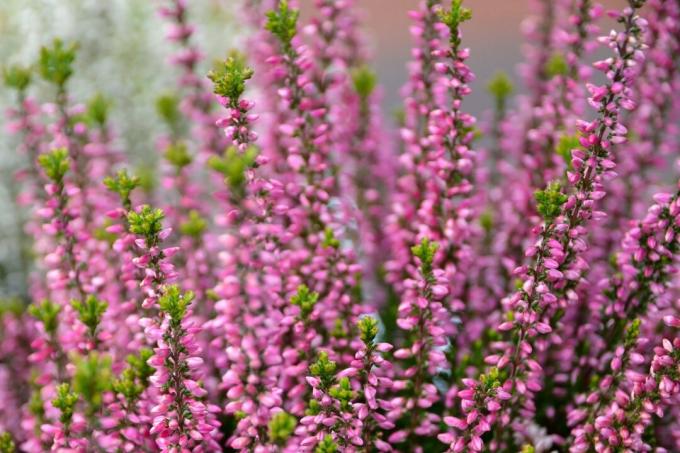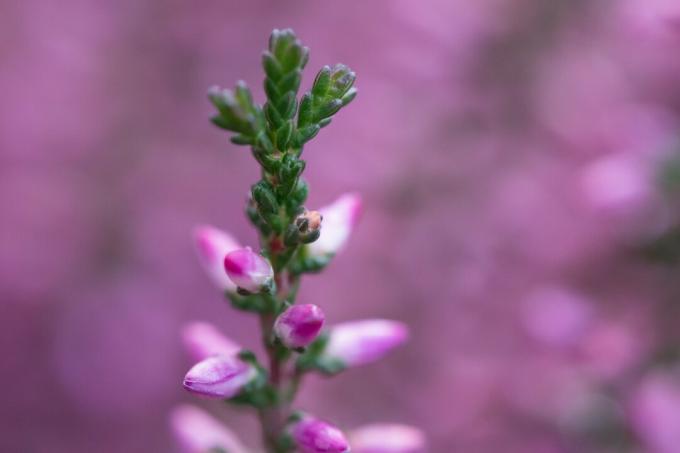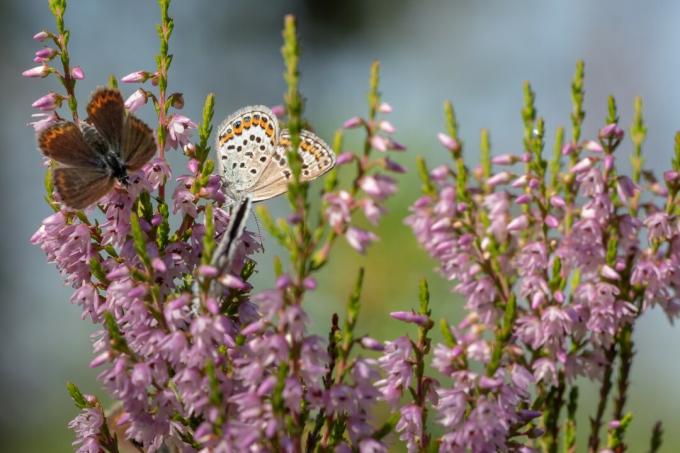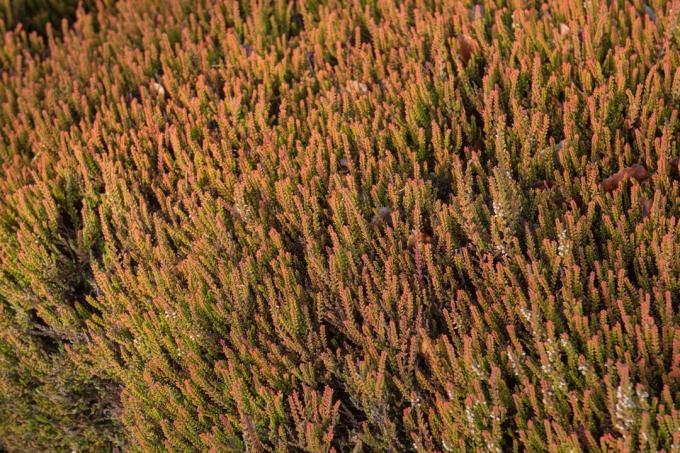The Lüneburg Heath, which blooms magnificently in late summer, is a very popular destination. The heather responsible for this is robust and insect-friendly. As Calluna vulgaris You can find out about planting and maintaining in your garden here.

Calluna vulgaris is easy to care for and extremely popular. It is also a low-growing plant that is also suitable as a ground cover. And nectar is in great demand, especially with insects. How to simply plant and overwinter the common heather, you will find out in this article.
contents
- Common heather: flowering period and profile
- The most beautiful Calluna vulgaris varieties
- Planting Calluna: location, timing and procedure
-
Care of the common heather
- Water and fertilize
- Cut heather
- Is Calluna vulgaris hardy?
- Propagate common heather
- Use and effects of common heather
- Is Calluna Vulgaris Poisonous?
Common heather: flowering period and profile
The following table gives you a brief overview of the perennial common heather.
| origin | Northern and Central Europe |
| Growth habit | Evergreen dwarf shrub, upright growth |
| Height | Between 30 and 50 cm |
| Heyday | August to November, depending on the variety |
| Flower colors | Mostly pink to slightly purple, there are also white varieties |
| Leaf shape | Narrow needle-shaped leaves, attached to the shoot in scales |

The terms common heather, budded heather and snow heather are often used synonymously. But that's not entirely true:
- What is the difference between common heather and bud heather? Bud heather or bud bloomer heather are varieties of common heather that never fully open their flowers, but only let the colorful petals peek out. This ensures that the flowers are not pollinated and last longer. Examples of heather buds are the “Garden Girls” and the “Beautyladys”, which are not varieties but rather brand names of breeders.
- Difference between snow heather and common heather: snow heather (Erica carnea) and common heather belong to different heather genera, but both are representatives of the heather family (Ericaceae). More about the Snow heather you can read in our special article.
Is the common heather bee-friendly?
Common heather is very bee-friendly and the nectar on the flowers is easily accessible. The flowers of Calluna vulgaris are very popular with insects such as bees and bumblebees, but also butterflies. Only the heather buds and filled varieties of Calluna vulgaris, for example ‘Annabell’, are not suitable as a bee pasture.

The most beautiful Calluna vulgaris varieties
There are many different varieties of common heather available from specialist gardeners. Below we introduce you to the most important types of Calluna vulgaris before.
- "Carmen": The double, purple-colored flowers open in their grape-shaped inflorescences in August and September. The dark green leaves provide a nice contrast. The height is between 30 and 40 cm.
- ‘Darkness’: It is a variety with purple flowers in dense inflorescences that bloom from August to October. With a height of 30 to 40 cm, ‘Darkness’ is relatively small. The leaves on the dense shoots are light green.
- "Firefly": The leaves are special with this variety. First appearing brownish yellow in autumn, they turn bright orange in winter. The flowers are dark pink and bloom from August to September. A maximum height of 45 to 50 cm is achieved.

- "Jana": This variety is characterized by a small height and a late flowering period. The pink to red double flowers appear from September to November. This variety grows between 20 and 30 cm with light green leaves.
- ‘Kinlochruel’: This common heather shows its double white flowers between August and October. With a stature height of 30 cm, it is also relatively small. The leaves are colored green.
Planting Calluna: location, timing and procedure
Planting the common heather is recommended in late summer or autumn. The location in the garden should be sunny to slightly partial shade. A sandy soil with humus content is optimal, a good drainage is important for the common heather in the garden, since waterlogging and dense soil are not tolerated. In addition, the pH of the soil should be acidic. If you have a rather loamy soil, you can adapt it to the conditions of the Calluna adjust. Sand creates a looser structure in the soil. Acid earth - like our reduced peat Plantura Bio-Acid Soil - additionally loosens and at the same time ensures the correct pH value. Peat is an ideal basis for many bog plants, as it ensures a lower pH value and protects against dehydration. However, since peat is also a valuable raw material, we made a conscious decision to use our Producing acidic soil with reduced peat - and thus a sustainable alternative to conventional bog soil to offer.
Calluna vulgaris makes an excellent area-wide ground cover with a distance of about 20 cm between the plants. When planted in smaller or larger groups, the common heather looks and grows well. They should not be planted individually, otherwise the plants cannot form a beautiful carpet of flowers - the effect as a ground cover is therefore lost. They are also much more sensitive to frost.
Tip: Before planting, it is important that you loosen the root ball of the common heather with your hands to allow the roots to grow in optimally. The soil should be kept moderately dry to moist. Waterlogging is to be avoided at all costs.

Common heather on the balcony: Common heather can also be planted on the terrace and balcony. A sunny balcony works well, otherwise it is too shady. Acid earth can be mixed with perlite or about 30% broken expanded clay so that there is sufficient drainage and waterlogging is avoided. If the heather in the pot is completely dry, a quick water bath is helpful. To do this, the pot can be immersed until no air bubbles rise. When planting in a pot, you should think about how many plants you want to plant beforehand. Because here, too, it is essential to maintain the planting distance so that you can still have some of the common heather after a season. Depending on the number of plants, a sufficiently large planter should be selected in which the common heather has sufficient root space. The soil should always be kept moderately moist.

Care of the common heather
Common heather is very robust and easy to care for. In order to ensure vigorous and beautiful growth, there are a few small points to consider when caring for it.
Water and fertilize
The soil in which Calluna vulgaris is planted, must not be too dry. In this respect, regular watering is absolutely necessary. Lime-free rainwater is particularly suitable for this.
Fertilizing the common heather in spring is also recommended for healthy growth. Since the plants prefer acidic soil, an appropriate fertilizer is also appropriate. For example, ours is suitable Plantura organic hydrangea fertilizermade from 100% natural raw materials. For healthy growth, the heather has an increased need for nitrogen and potassium. The fertilizer with its specially designed composition does justice to this. The fertilizer is also well suited for common heather growing in pots.
Cut heather
Pruning the common heather is essential to maintain healthy growth and abundant flowering. In spring, i.e. in March or April, the cut should be made in cloudy weather. The new shoot from last year can be cut by around half. The plants are not very sensitive; in the case of large areas, the cut can also be made with a hedge trimmer or brushcutter.
Is Calluna vulgaris hardy?
Generally, common heather is hardy. However, you should mulch your plants before the first winter, as the winter hardiness is not yet fully developed. Temperatures can be chilly after the first year Calluna vulgaris have nothing on them anymore. However, it is essential to ensure that there is sufficient moisture, especially when it neither snows nor rains in winter, because winter drought can cause lasting damage to the plants. Water your heather on mild days.

Propagate common heather
The easiest way to propagate the common heather is to use a sinker. To do this, the shoot is pressed to the ground in autumn, covered with some earth and weighted down so that it stays underground. When there is contact with the ground and there is sufficient moisture, roots form and over time a new plant emerges that can even be transplanted in spring next autumn.

Use and effects of common heather
Already in the 19th Century found Calluna vulgaris Application in medicine. Diseases of the respiratory and urinary tract were treated with an infusion. But also all kinds of skin irritations could be alleviated with the common heather. Today it is mainly used for the production of heather honey.

Is Calluna Vulgaris Poisonous?
Neither flowers nor leaves of Calluna vulgaris are poisonous to cats, dogs, or humans. The common heather can therefore be planted in the garden or on the balcony without any problems.
Are you interested in autumn flowers? In our special article we provide the most beautiful autumn flowers before.



